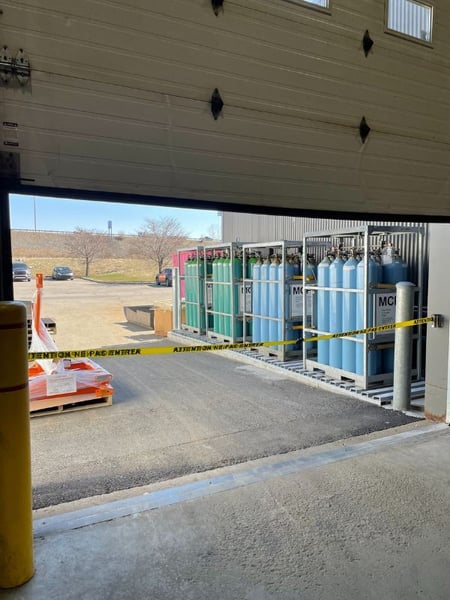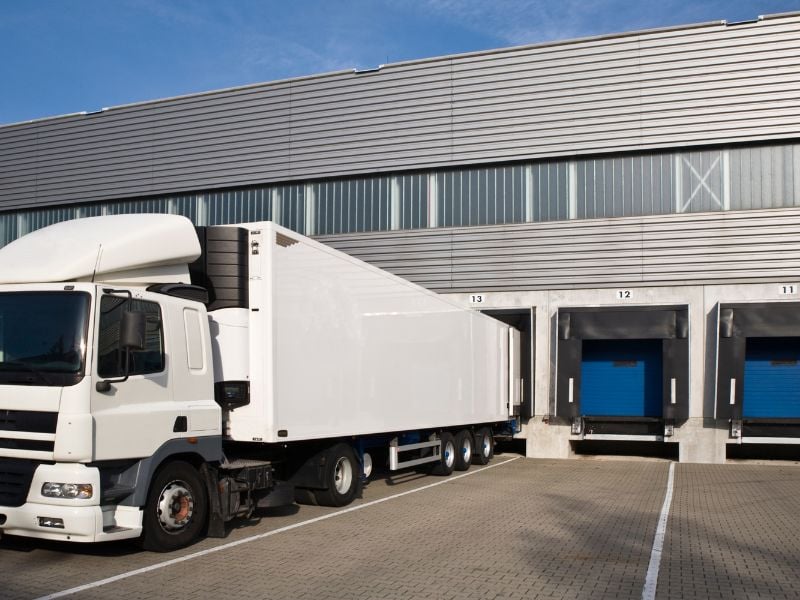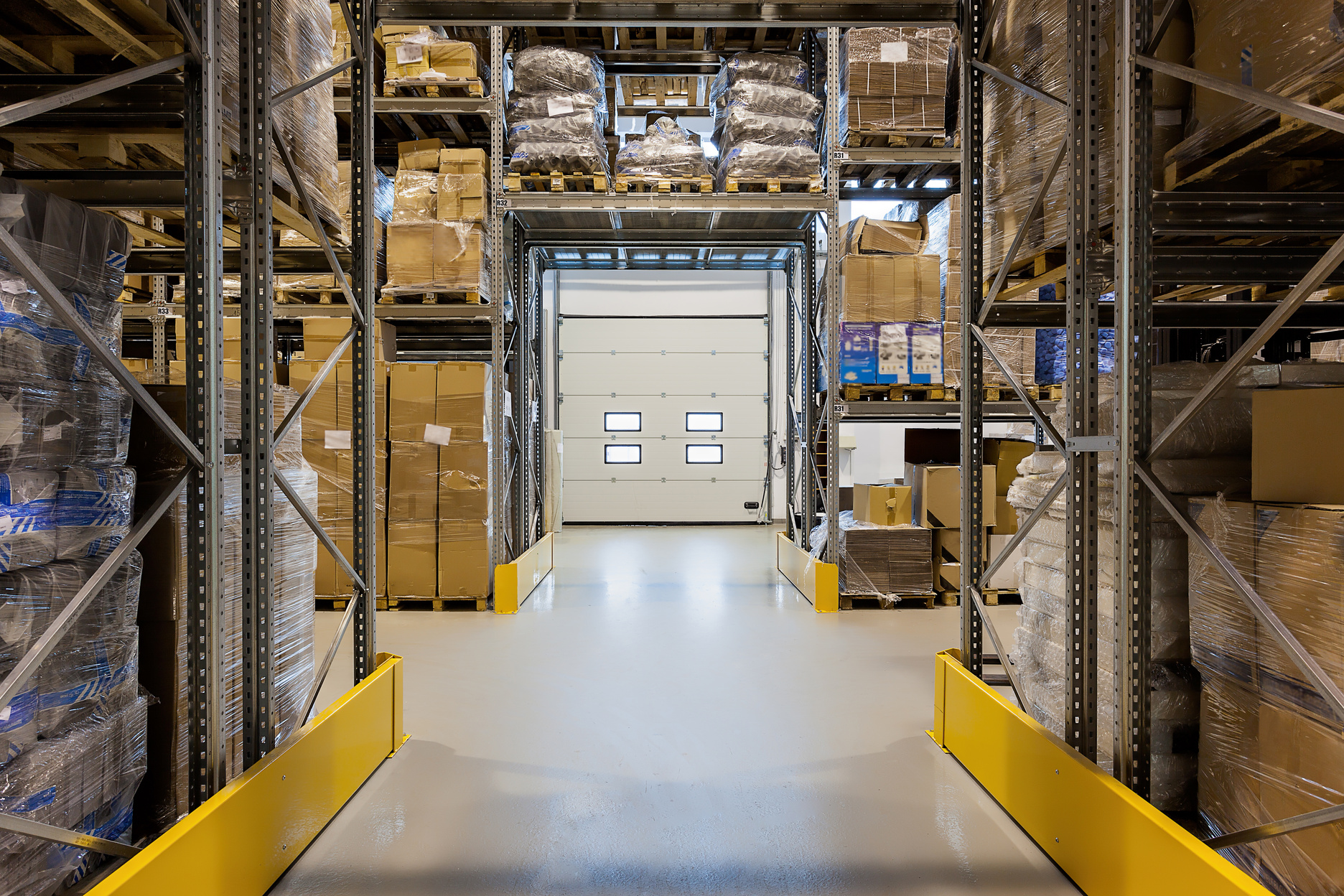Loading docks are among the busiest areas in a warehouse, making them vulnerable to accidents and damage. 25% of all reported warehouse injuries happen on or near the loading dock. With constant traffic, heavy equipment in motion, and the pressure of loading and unloading trucks, safety isn’t optional—it’s essential. Lives, uptime, and profit are all at stake.
In this article, we’ll explore best practices for loading dock safety, including the importance of protective measures like dock ramps, truck restraint systems, and rack protection solutions. You’ll also gain access to a practical safety checklist with key questions to help you evaluate the safety level of your loading docks and reduce risk.

Jump to Section
- What Is the Difference Between a Loading Bay and a Loading Dock?
- What Is a Loading Dock, in More Detail?
- What Is Loading Dock Safety?
- Why Is Loading Dock Safety Essential?
- Common Hazards at Loading Docks and How to Prevent Them
- What Are the Safety Requirements for Loading Docks?
- How to Make Your Warehouse Loading Dock Safer
- Practical Safety Checklist
What Is the Difference Between a Loading Bay and a Loading Dock?
The terms “loading bay” and “loading dock” are sometimes used interchangeably, but they have distinct definitions:
A loading bay is a large space, not necessarily elevated, that aligns with the height of truck beds. This more general term can also include open spaces for staging goods before or after loading and unloading.
A loading dock is typically an elevated structure integrated into a warehouse or distribution center. It is designed to align with truck beds for the loading and unloading of goods.
Understanding this difference can help businesses optimize their logistics and warehouse layout. In this blog, we will focus on loading dock safety.
What Is a Loading Dock, in More Detail?
A warehouse loading dock is a designated elevated area in a warehouse or distribution center where trucks load and unload goods. It serves as an access point between transportation and storage, allowing for the efficient movement of inventory. Loading docks can be equipped with ramps, dock levelers, bumpers, and safety equipment to facilitate operations and prevent accidents.

Image: Example of a vehicle restraint
What Is Loading Dock Safety?
Loading dock safety refers to the measures, best practices, and equipment used to prevent injuries, accidents, and structural damage in warehouse dock areas. This includes the use of proper barriers, clear communication between truck drivers and warehouse staff, and employee training on safe loading and unloading procedures.
Why Is Loading Dock Safety Essential?
According to OSHA, warehouse loading docks are hazardous work zones, contributing to a significant number of injuries and even deaths each year. It is estimated that 25% of warehouse accidents occur near a loading dock.
The main risks include slips, falls, collisions, and equipment failure. Prioritizing loading dock safety helps businesses:
- Protect employees–Reduce the risk of injuries caused by falls, equipment failure, or vehicle accidents.
- Prevent structural damage–Minimize wear and tear on docks, trucks, and equipment through proper safety solutions.
- Ensure operational efficiency–Avoid costly disruptions caused by accidents, repairs, or damaged inventory.
To better understand loading dock safety, we’ll take a closer look at common hazards.

Common Hazards at Loading Docks and How to Prevent Them
Warehouse loading docks present several hazards that can lead to serious injuries or operational disruptions, including:
1. Falls from the Warehouse Loading Dock
Loading docks are often elevated by 1.20 meters or more, and workers are at risk of slipping or falling without adequate barriers or protections.
Prevention Tips:
- Install dock barriers, guardrails, or safety gates to prevent falls.
- Keep dock surfaces dry and free of debris to reduce slip hazards.
- Mark the edges of the docks with visible, bright lines to improve awareness.
2. Forklift and Other Vehicle Accidents
Forklifts frequently travel between trucks and the warehouse, increasing the risk of collisions or tipping over. Additionally, if a truck departs from the dock too early before the loading is completed, it can create a dangerous gap for workers and goods.
For example, in 2024, OSHA was notified that an employee working as a shipping and receiving clerk died after falling approximately 47 inches from a loading dock to the ground while a semi-truck was backing in.
Prevention Tips:
- Use wheel chocks or vehicle restraint devices to prevent trucks from departing prematurely.
- Train forklift operators to approach docks with caution and adhere to speed limits.
- Implement a communication system using lights or signals to indicate when trucks are secured and ready for loading/unloading.
3. Damaged or Worn Dock Equipment
Over time, dock bumpers wear out, reducing their ability to absorb truck impacts and protect dock structures. Similarly, dock ramps can become uneven or unstable, creating hazards for forklifts and workers.
Prevention Tips:
- Regularly inspect and replace dock bumpers to maintain impact protection.
- Ensure that dock ramps are securely fixed, have non-slip surfaces, and can support the required load.
- Plan for regular dock maintenance to detect cracks, misalignments, or structural damage.
4. Insufficient Lighting and Poor Visibility Near Warehouse Loading Docks
Inadequate lighting or reduced visibility can lead to misjudgments, increasing the risk of accidents, especially in busy warehouse environments where quick movements are required.
Prevention Tips:
- Install powerful LED lights on docks to improve visibility, especially during night operations.
- Use safety mirrors and cameras to help workers see blind spots.
- Ensure that hazard signs and markings are clear and well-maintained.

Implementing proper safety measures helps reduce these risks and ensures smooth loading dock operations.
What Are the Safety Requirements for Loading Docks?
Loading docks must meet specific safety requirements to protect workers and prevent accidents. Under OSHA’s General Duty Clause (Section 5(a)(1) of the Occupational Safety and Health Act), employers are required to ensure that the organization of work and the methods used at loading docks are free from recognized hazards that could cause death or serious physical harm.
OSHA outlines several key standards, including:
- Fall Protection (OSHA 1910.28)–Loading docks higher than 1.20 meters must be equipped with barriers, guardrails, or safety gates to prevent falls.
- Forklift Safety (OSHA 1910.178)–Operators must be trained and certified to use forklifts in dock areas.
- Dock Equipment Standards–Ramps, bumpers, and levelers must be well-maintained to avoid structural failures.
- Clear Traffic Paths–Aisles must be clearly marked to separate pedestrians from vehicle traffic.

Image: Example of a loading dock leveler
Reminder: Making Your Warehouse Loading Dock Safer
To improve loading dock safety, businesses should implement the following measures:
1. Invest in Durable Loading Dock Bumpers
Trucks frequently reverse into docks, and without adequate protection, repeated impacts can lead to structural damage, costly repairs, and even safety hazards.
High-quality dock bumpers act as a cushion, absorbing impact forces to minimize wear on the loading dock.

Image: Loading Dock Bumper
2. Maintain Stable and Safe Loading Dock Ramps
A well-organized warehouse loading dock helps minimize congestion and the risk of confusion. Here are a few recommendations:
- Designate separate lanes for trucks, forklifts, and pedestrian traffic.
- Use signal lights at the docks to indicate the loading/unloading status.
- Implement a clear communication system between truck drivers and warehouse staff.

Image: Safety and signaling products for warehouse loading docks
3. Maintain Stable and Secure Loading Dock Ramps
Dock ramps are critical elements connecting trucks to warehouses, allowing forklifts and workers to move safely. Worn or unstable ramps can lead to misalignment, damage to equipment, and serious accidents.
4. Protect Rack Columns Adjacent to Loading Dock Doors
Forklifts and pallet jacks maneuvering in these areas may accidentally hit rack frames, causing structural damage. Rack protectors placed near dock doors play a crucial role in protecting rack frames, which are often exposed to violent impacts.
Rack components are expensive to repair and are strategically located in high-traffic areas. Installing robust protectors limits these risks, reduces operational disruptions, and enhances the overall safety of the warehouse.

Image: Damo Frame Guard safeguards dock door frames.
5. Train Employees on Loading Dock Safety
Even with the best equipment, human error remains one of the main causes of accidents in warehouses. Regular training helps reinforce best practices and ensures that everyone follows safety procedures.
Topics to Cover During Training:
- Safe use of forklifts and loading dock approach techniques.
- Emergency response procedures in case of an accident or dock malfunction.
- Best practices for loading and unloading.

6. Conduct Regular Safety Inspections and Maintenance
Preventive maintenance is essential to ensure the safety and proper functioning of loading docks. A structured inspection program helps identify hazards before they lead to accidents.
Checklist for Regular Dock Inspections:
- Check the condition of dock bumpers and replace them if necessary.
- Inspect the stability and fastening of dock ramps.
- Ensure that wheel chocks and vehicle restraint systems are functioning properly.
- Test dock lighting, mirrors, and signage to ensure good visibility.
- Look for cracks or structural issues in the dock area.
By adopting these proactive measures, warehouses can significantly reduce accident risks and ensure smooth operations.

Conclusion: Loading Dock Safety is a Priority
A well-maintained warehouse loading dock is key to ensuring operational efficiency, worker safety, and equipment longevity. By implementing concrete measures such as installing durable dock bumpers, regularly maintaining ramps, and rigorously managing traffic, businesses can significantly reduce accident risks and damage-related costs.
That being said, loading dock safety is just one link in the warehouse safety chain. For optimal protection of your warehouse, staff, and goods, it is also essential to implement a comprehensive rack safety program. This program includes regular assessment of racking systems, preventive maintenance, adherence to safety standards, and ongoing staff training.
The goal is to prevent incidents, protect inventory, and create a safe and efficient working environment. This strategy strengthens team confidence, improves productivity, and generates long-term savings.
Do you have questions or want to improve safety in your warehouse? Contact our rack experts—we are here to help.
[1] Source (original document in French):
Giraud, L., Koutchouk, M., Dubé, P. A., Drolet, D., & Gratton, L. (2007). Loading dock safety: How safe are your company’s docks? Technical data sheet (Sheet No. RF-502). [French only]. https://pharesst.irsst.qc.ca/fiches/58/












